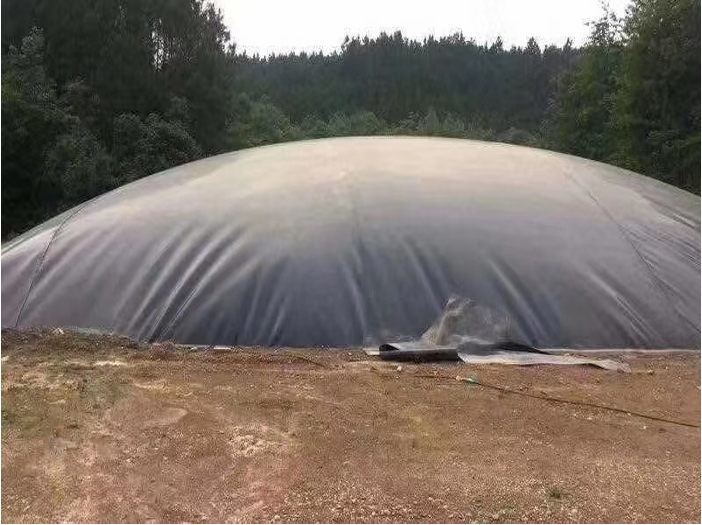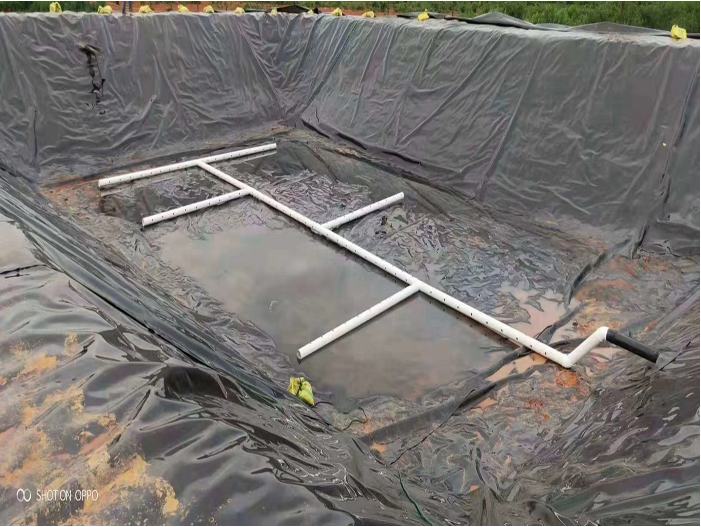 Biogas digester geomembrane is essential in aquaculture. With the rapid development of the breeding industry, the industry segmentation of livestock breeding in various places has become more obvious, and the reuse of energy has gradually been put on the agenda.The wastewater discharged from aquaculture produces biogas by building biogas digesters, and the generated biogas can be used for daily cooking, power generation and other purposes.Now pig farms are being built all over the country, and the anti-seepage of the oxidation pond and anaerobic pond in the pig house must be done well. This article takes a large pig farm as an example to analyze the use of geomembrane for the construction of biogas digesters.
Biogas digester geomembrane is essential in aquaculture. With the rapid development of the breeding industry, the industry segmentation of livestock breeding in various places has become more obvious, and the reuse of energy has gradually been put on the agenda.The wastewater discharged from aquaculture produces biogas by building biogas digesters, and the generated biogas can be used for daily cooking, power generation and other purposes.Now pig farms are being built all over the country, and the anti-seepage of the oxidation pond and anaerobic pond in the pig house must be done well. This article takes a large pig farm as an example to analyze the use of geomembrane for the construction of biogas digesters.
The choice of geomembrane as the construction material during the construction of biogas digesters has become everyone’s first choice, because geomembrane has low price, fast construction and long service life compared with other materials. According to the standard biogas digester construction, the CJ-T234-2006 standard needs to be adopted. Geomembrane, thickness ≥1.5mm. The scientific name of biogas digester is "fully enclosed anaerobic pond". The black membrane biogas digester integrates fermentation and gas storage. The entire anaerobic pond is fully enclosed by using geomembrane materials. It has the advantages of simple and convenient construction, rapid construction, low cost, simple process flow, convenient operation and maintenance, long sewage retention time, and sufficient digestion,the sealing performance is good, the daily output of biogas is large, the biogas can be used to generate electricity, the black film absorbs sunlight, the temperature and moisturizing effect is good, the bottom of the pool is equipped with an automatic sludge discharge device, and the amount of sludge in the pool is small.

The construction of the black film biogas digester is firstly carried out by excavating the farm biogas digester according to the required size. The slope is less than 40,and the slope transition is gentle, all the internal and external corners are chamfered, The base surface after dried, compacted, flat, without cracks, obvious sharp protrusions and depressions.no tree roots, rubble, stones, steel bars, glass chips and other sharp debris within the vertical depth of 25mm. Its flatness changes gently within the allowable range, the slope is uniform, and the slope is consistent, and meets the design requirements of "Technical Specification for HDPE Anti-seepage Membrane Anti-seepage Engineering" (industry standard SL/T231-98),the internal and external corners places on the base surface should be smoothly transitioned, and the radius should not be less than 0.5m. The surface of the base is dry, and the compaction degree of rolling meets the design requirements.and an anchoring ditch is excavated along the side of the biogas digester 1.5m. The size of the anchoring ditch is 1m*1m, and the limited internal and external corners are rounded and chamfered. After the HDPE geomembrane is laid, the plain soil is filled with a thickness of 20cm. After the membrane is laid, the anchoring ditch is filled with plain soil and compacted.

Laying the bottom film and installing the pipeline (it is recommended to use the American standard geomembrane over 1.0mm for the bottom film). Laying HDPE geomembrane is a key process in the entire anti-seepage system. Before laying, the construction department shall inspect and accept the base in conjunction with relevant departments. Check the appearance quality of HDPE geomembrane before film laying, record and repair the found mechanical damage and production wounds, holes, breakage and other defects. Before the HDPE geomembrane is cut, its relevant dimensions are measured, and then according to the actual cutting, the pieces are numbered and recorded, and the site is numbered on the floor plan. In the film laying, the overlapping width of the seam between the film and the film is not less than 100mm, so that the direction of the seam arrangement is parallel to the toe line, that is, along the slope direction. Auxiliary materials such as rope ladders are needed in the process of laying the base film. After the film is laid, in general slopes and sites, the laying team will check the number of each piece of film in the laying area and the number of the floor plan, and confirm that it is correct.After that, use sandbags for temporary anchoring immediately according to the specified position of the film, and then check that the overlapping width of the film is not less than 10cm, and adjust when necessary to make full preparations for the next process. Then lay the HDPE geomembrane of the slope in sequence, and cut the membrane in the irregular range such as corners into an inverted "trapezoid" with a width at the top and a small at the bottom. Its width and narrow ratio should be calculated by the operator according to the actual situation of the site and the specific size of the slope.If the ratio is inaccurate, it will cause the membrane surface on the slope to "bulge" or "dangling". The key point of this step is the bonding between the pipeline and the geomembrane. It must be carefully wrapped with an extrusion welding machine to prevent poor bonding.